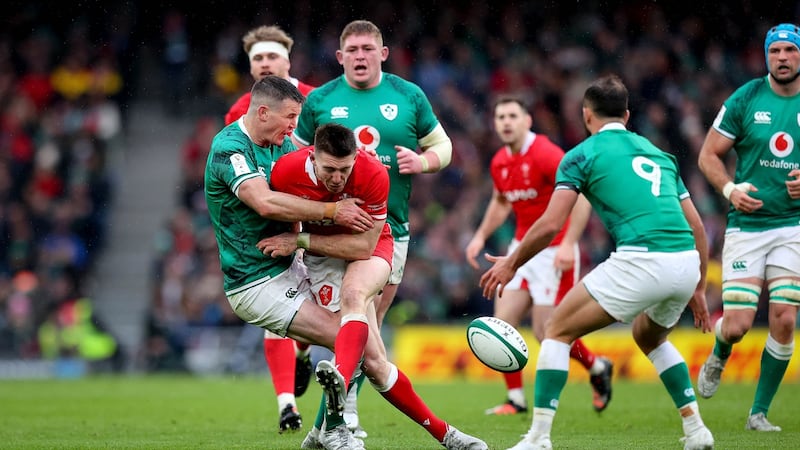Johnny Sexton’s pre-eminence as the controller-in-chief of Ireland’s attacking patterns was once again in evidence at the Aviva stadium, his ability to pick and choose from the menu of options near-flawless on an afternoon when the weather conditions, rain and high winds militated against such fluency.
As if to prove he wasn’t an automaton, he pushed a couple of penalty opportunities to the right of the posts, with a similar shove to an errant conversion. That’ll grate. But even in this narrow facet of his performance review, Sexton still demonstrated his class with three touchline conversions, the first a wonderfully pure strike and the others beautifully judged as they rode the wind to bisect the posts.
Sexton's game has evolved under the coaching baton of Andy Farrell and Mike Catt; there are more subtleties to the way he plays, often not the primary receiver but instead hidden in a green backfield of faces, waiting to pounce.

It mitigates to a point the jeopardy of watching opponents tee off on him physically when plays flat to the gain line, willing to take punishment in the hope of putting a team-mate through a gap. Wales centre Josh Adams couldn't resist the siren call of "emptying" the Ireland captain, but his action was reckless and the censure of a yellow card merited; a costly indiscretion.
On foot of a fortuitous ricochet from a grubber that allowed Mack Hansen to escape up the wing, Sexton's next involvement was definitive. His decision to switch from open to blindside at the last second was picked up by Tadhg Beirne, who gave his captain the ball and from there Sexton and Hansen combined to send Bundee Aki over unopposed.
Heavy lifting
Aki performed a great deal of the heavy lifting for Sexton, slotting in at first receiver – Garry Ringrose also popped up there on occasion – and when not taking contact, the Connacht centre afforded his outhalf a little more time and space in the backfield.
Sexton made good use of that latitude in both his distribution and also in personally prising opening space in the Welsh defence; there were three or four occasions when dummying a pass allowed him to surge through a gap.
He also benefits hugely from the dexterity of his forwards, whose ability to drop the ball off with precision means that Sexton’s next touch is often to get his team to the edges out wide. He would be the first to acknowledge the speed of ruck ball and the quicksilver service from Jamison Gibson-Park.
A minor cavil in a general sense is that for all the excellent endeavour, Ireland’s attacking orientation was a little east-to-west at times (Wales often had three defenders confronting the last Irish player out wide), something that will be polished in training this week to guarantee a better return from the creativity.
The occasional lateral drift aside, there was much to admire, Sexton using the inside pass to good effect, especially when linking with Josh van der Flier. Sexton didn't neglect the defensive side of his duties, joining Beirne in a double tackle on Ryan Elias that forced a turnover.
Not everything stuck. His attempted offload in the Welsh 22 was intercepted by Johnny McNicholl. It didn't cost him a second thought based on the way in which he started the second half, his footwork to beat a defender and inside pass to Ringrose the precursor to a 30-metre cut-out pass that Andrew Conway did brilliantly to finish for his first try.
Maxed out
Even in something as mundane as claiming the ensuing restart, Sexton maxed out his impact with a 50-metre clearance to touch. His next line kick was a doozy, arrow straight into the corner that gave Ireland the perfect platform to launch another assault.
Sexton brings order and composure to Ireland’s patterns, possesses the vision, the big-game nous honed by experience to make many excellent judgment calls under pressure. He may no longer be perpetually front of house in the Irish backline from a physical perspective, but that phrase does define his role.
The raft of changes on both sides was always going to remove a little of the structure and cohesion from the game, and the rugby lost its way in the final quarter a bit, submerged under errors. By that stage Sexton was sitting in the stand with nothing more strenuous than a watching brief, perhaps allowing a fleeting thought about doing it all again in Paris next Saturday.





















